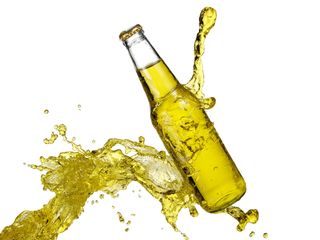The Truth About Yellow Dye No. 5


Unfounded rumors about artificial food additives being unsafe are typically harmless, because consumers can't hurt themselves by cutting back on a chemical that is devoid of nutritional value. But in the case of the synthetic food dye tartrazine, better known in the United States as Yellow No. 5, one rumor became more dangerous than the additive itself. Meanwhile, consumers overlooked another, more insidious, potential side effect of the chemical.
In the late 1990s, fast-paced youngsters turned to a caffeinated beverage easily distinguished from the coffee of their parents' generation: Mountain Dew. This soda, which packed a caffeine wallop half again as potent as Coke or Pepsi, was bubbly, fruity, and most importantly, neon yellow.
The rumor that swirled round Mountain Dew came in different shapes and sizes, but the upshot was always the same: Yellow No. 5, the dye responsible for the Dew's unnatural hue, affected men in a bad way. Some claimed it shrunk or shriveled masculine body parts, but for the most part it was said that tartrazine laid waste to a man's sperm count.
At the time, there was no scientific evidence to support the urban legend, nor was there any reason the myth focused so exclusively on Mountain Dew —tartrazine could be found in comparable concentrations in foods and drinks ranging from pickles to marshmallow Peeps to macaroni and cheese. But some people cut back on their consumption of the soda anyway, worried about its effect on their reproductive health.
But others banked on the rumors being true: they doubled down on the Dew, thinking it would function as a contraceptive.
It's impossible to say how many, if any, couples relied solely on Mountain Dew for birth control. But it was enough of an issue that the Wall Street Journal ran an article about it, as did a number of city and university newspapers. Dear Abby even warned her readers not to rely on the soft drink to prevent pregnancy.
Even today, queries about Mountain Dew's purported spermicidal effects can be found in Internet health forums.
Sign up for the Live Science daily newsletter now
Get the world’s most fascinating discoveries delivered straight to your inbox.
But prophylactic properties aren't the only side effects that have been attributed to tartrazine. In 1975, Ben Feingold, the chief allergist at Kaiser Permanente Medical Center in San Francisco, proposed the idea that it and other synthetic food dyes could cause hyperactivity in some children.
Since then, studies have both supported and rebutted this idea, but Feingold's hypothesis gained renewed steam in 2007, when a large-scale study revealed that some children displayed increased hyperactivity when given a mix of artificial colors.
In 2010, artificial food dyes made news yet again when an internal U.S. Food and Drug Administration memo acknowledged that "for certain susceptible children with ADHD and other problem behaviors, the data suggest that their condition may be exacerbated by exposure to a number of substances in food, including, but not limited to, artificial food colors." Very slightly reassuringly, the memo said these effects were "due to a unique intolerance to these substances, and not to any inherent neurotoxic properties."
Today, tartrazine and other artificial food dyes require a special warning on food packages sold in the European Union. No such warning requirement exists in the United States, although tartrazine (or Yellow No. 5) is always identified on ingredients lists when used in packaged foods, for the sake of the estimated 1 in 10,000 people who suffer allergic reactions to the chemical.
The safety of tartrazine for the general population of children is still open for debate. Most are unaffected by artificial food colorings, but it does seem to alter the behavior of some, especially those diagnosed with hyperactivity.
Clouding the issue is the fact that many of the studies that have been done tested a mixture of food colorings, so it's difficult to determine which chemical altered behavior, if there was any one culprit. To make matters more confusing, children who are sensitive to artificial food colorings also tend to be affected by other foods, such as wheat and milk.
If tartrazine's effect on hyperactivity remains unsolved, at least it's clear that it has no effect on sperm count, right? Not so fast. Recently, two small studies in mice — one from Algeria in 2009 and one from India in 2010 — linked tartrazine intake with slightly decreased sperm production. It remains to be seen whether those results will stand up to further scrutiny, or apply to people.
But in the meantime, its safer to assume that Mountain Dew, and anything else not explicitly sold as a contraceptive, will not prevent pregnancy.
Pass it on: Tartrazine has little or no effect on sperm count, but may affect behavior in predisposed children.
Food Facts explores the weird world of the chemicals and nutrients found in our food, and appears on MyHealthNewsDaily on Fridays. Follow MyHealthNewsDaily on Twitter @MyHealth_MHND. We're also on Facebook & Google+.
More Food Facts columns:
Most Popular

